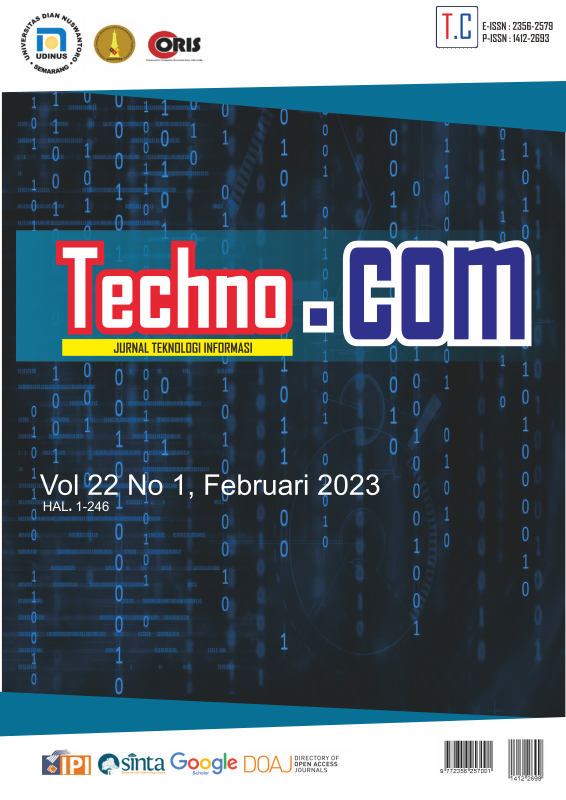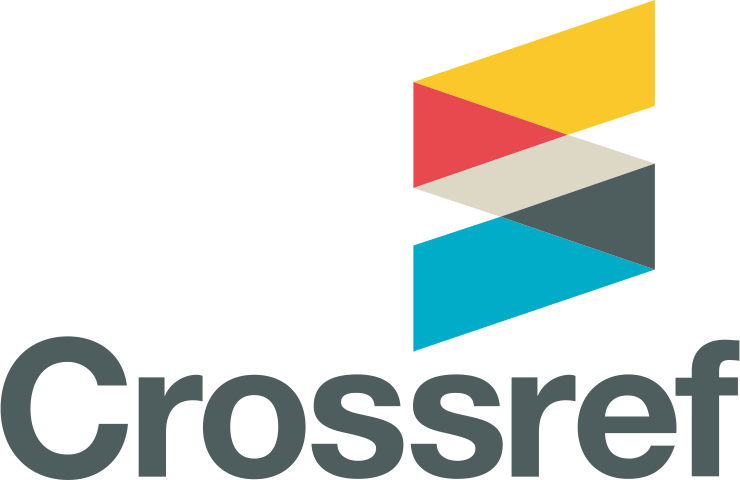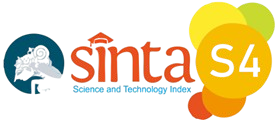Pemanfaatan sensor proximity untuk memantau kesehatan reproduksi puyuh bagi peternak telur puyuh
DOI:
https://doi.org/10.33633/tc.v22i1.7111Keywords:
IoT, dashboard, puyuh petelur, MQTT Panel, sensor infrared proximityAbstract
Perkembangan Internet of Things(IoT) berbasis mikrokontroler semakin meningkat bahkan sudah banyak diterapkan di berbagai sektor. Dengan menggunakan IoT) kita dapat mengendalikan dan memonitor perangkat dari jarak jauh dengan bantuan internet sebagai media komunikasi. Salah satu sektor yang belum menggunakan IoT adalah peternak telur puyuh untuk memonitor produktivitas puyuh petelur. Sensor infrared proximity E-18 D80NK digunakan untuk mendeteksi jumlah telur pada setiap kandang yang dikendalikan dengan mikrokontroller ESP32. Output ditampilkan pada LCD 16x2 dan juga dikirimkan ke broker hivemq melalui jaringan internet. Hasilnya adalah berupa dashboard sederhana yang menampilkan jumlah telur pada kandang melalui aplikasi IoT MQTT Panel. Apabila jumlah telur kurang dari 90% dari jumlah puyuh petelur maka saat itu peternak perlu menambahkan vitamin untuk mengembalikan kesehatan puyuh petelur agar jumlah telur dapat mencapai 100% produktivitas.References
Z. Poli, F. H. Elly, and J. Husain, “Produksi dan keuntungan usaha ternak puyuh sebagai pendapatan alternatif,” Zootec, vol. 41, no. 1, p. 36, 2021, doi: 10.35792/zot.41.1.2021.31637.
Y. Triutami and T. R. Saraswati, “Kuantitas Produksi Telur Puyuh (Coturnix coturnix japonica L) Setelah Pemberian Cahaya Monokromatik,” Kuantitas Produksi Telur Puyuh (Coturnix coturnix Jpn. L) Setelah Pemberian Cahaya Monokromatik, vol. 24, no. 1, pp. 56–65, 2016.
L. Wangefela, N. M. Santa, A. H. . Salendu, and L. S. Kalangi, “Analisis Margin of Safety Usaha Peternakan Puyuh ‘Merryland’ Di Desa Kali Kecamatan Pineleng Kabupatn Minahasa,” Zootec, vol. 38, no. 1, p. 183, 2018, doi: 10.35792/zot.38.1.2018.18672.
T. Putra, Gilang Muhammad, Hasni, “SISTEM PENETAPAN HARGA POKOK PENJUALAN TELUR PUYUH ( Coturnix – coturnix japonica ) PADA USAHA TERNAK PUYUH,” pp. 16–25, 2022.
G. M. Putra, “Sistem Penetapan Harga Pokok Penjualan Telur Puyuh ( Coturnix – Coturnix Japonica ) Pada Usaha Ternak Puyuh (Studi Kasus Di Peternakan Puyuh Soreang Kab. Bandung),” Students e-Journal, vol. 3, no. 4, 2014, [Online]. Available: http://jurnal.unpad.ac.id/ejournal/article/view/6117%0Ahttp://jurnal.unpad.ac.id/ejournal/article/download/6117/3168.
M. Destia, D. Sudrajat, and E. Dihansih, “LENGTH AND WIDTH RATIO EFFECT TO QUAIL PRODUCTIVITY (Coturnix coturnix japonica) IN PRODUCTION PERIOD,” J. Peternak. Nusant., vol. 3, no. 2, p. 57, 2018, doi: 10.30997/jpnu.v3i2.925.
M. Firdaus and M. F. Maula, “Implementasi Sistem Kontrol Pakan Burung Puyuh Berbasis Mikrokontroler Dan Internet Of Things (Iot),” JE-Unisla, vol. 6, no. 1, pp. 443–447, 2021, [Online]. Available: http://jurnalteknik.unisla.ac.id/index.php/elektronika/article/view/574%0Ahttp://jurnalteknik.unisla.ac.id/index.php/elektronika/article/download/574/422.
Z. Abidin and N. A. A. Saragih, “Sistem Monitoring kandang burung puyuh berbasis IOT pada platform node-red menggunakan Naive Bayes,” Orphanet J. Rare Dis., vol. 21, no. 1, pp. 1–9, 2020.
A. Ulinuha and M. ‘Alim Alfaridzi, “Design and Implementation of Temperature Detection Gates and Hand Sterilization for Covid-19 Prevention,” Urecol Journal. Part E Eng., vol. 1, no. 1, pp. 28–38, 2021.
R. Paradila and M. Arifin, “Pengujian Rancangan Sistem Cuci Tangan Tanpa Sentuh Dengan Memanfaatkan E18-D80NK Infrared Proximity Sensor dan Solenoid Valve,” Pros. Semin. Nas. Fis., vol. 6, pp. 230–234, 2020.
A. Sirikham, P. Kirdpipat, and Y. Saeear, “Development of Bi-Directional Portable People Counter System based IoT,” Proceeding 2021 9th Int. Electr. Eng. Congr. iEECON 2021, pp. 503–506, 2021, doi: 10.1109/iEECON51072.2021.9440295.
M. H. Habibullah, “Desain dan Implementasi Sensor untuk Penyemprotan Disenfektan sebagai Pengendali Virus Corona,” Skripsi Univ. Muhammadiyah Surakarta, 2020.
Z. Mindriawan, I. W. A. Arimbawa, and I. G. P. S. Wijaya, “Implementasi Internet of Things Pada Sistem Monitoring Suhu dan Kontrol Air Pada Kandang Burung Puyuh Petelur dengan Menggunakan Protokol MQTT,” Univ. Mataram Repos., pp. 1–8, 2018, [Online]. Available: http://eprints.unram.ac.id/11498/.
V. Pravalika and C. Rajendra Prasad, “Internet of things based home monitoring and device control using Esp32,” Int. J. Recent Technol. Eng., vol. 8, no. 1 Special Issue 4, pp. 58–62, 2019.
A. Imran and M. Rasul, “Pengembangan Tempat Sampah Pintar Menggunakan Esp32,” J. Media Elektr., vol. 17, no. 2, pp. 2721–9100, 2020, [Online]. Available: https://ojs.unm.ac.id/mediaelektrik/article/view/14193.
A. Maier, A. Sharp, and V. Yuriy, “Comparative Analysis and Practical Implementation of the ESP32 Microcontroller Module for the Internet of Things,” 2017 Internet Technol. Appl., pp. 143–148, 2014.
Downloads
Published
Issue
Section
License
License Terms
All articles published in Techno.COM Journal are licensed under the Creative Commons Attribution-NonCommercial 4.0 International (CC BY-NC 4.0). This means:
1. Attribution
Readers and users are free to:
-
Share – Copy and redistribute the material in any medium or format.
-
Adapt – Remix, transform, and build upon the material.
As long as proper credit is given to the original work by citing the author(s) and the journal.
2. Non-Commercial Use
-
The material cannot be used for commercial purposes.
-
Commercial use includes selling the content, using it in commercial advertising, or integrating it into products/services for profit.
3. Rights of Authors
-
Authors retain copyright and grant Techno.COM Journal the right to publish the article.
-
Authors can distribute their work (e.g., in institutional repositories or personal websites) with proper acknowledgment of the journal.
4. No Additional Restrictions
-
The journal cannot apply legal terms or technological measures that restrict others from using the material in ways allowed by the license.
5. Disclaimer
-
The journal is not responsible for how the published content is used by third parties.
-
The opinions expressed in the articles are solely those of the authors.
For more details, visit the Creative Commons License Page:
? https://creativecommons.org/licenses/by-nc/4.0/
















